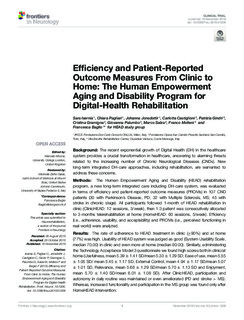| dc.contributor.author | Isernia, S. | |
| dc.contributor.author | Pagliari, C. | |
| dc.contributor.author | Jonsdottir, J. | |
| dc.contributor.author | Castiglioni, C. | |
| dc.contributor.author | Gindri, P. | |
| dc.contributor.author | Gramigna, C. | |
| dc.contributor.author | Palumbo, G. | |
| dc.contributor.author | Salza, M. | |
| dc.contributor.author | Molteni, F. | |
| dc.contributor.author | Baglio, F. | |
| dc.date.accessioned | 2020-01-15T12:58:06Z | |
| dc.date.available | 2020-01-15T12:58:06Z | |
| dc.date.issued | 2019 | |
| dc.identifier.citation | Isernia, S., Pagliari, C., Jonsdottir, J., Castiglioni, C., Gindri, P., Gramigna, C., . . . , H. s. g. (2019). Efficiency and Patient-Reported Outcome Measures From Clinic to Home: The Human Empowerment Aging and Disability Program for Digital-Health Rehabilitation. Frontiers in Neurology, 10(1206). | nb_NO |
| dc.identifier.uri | http://hdl.handle.net/11250/2636438 | |
| dc.description.abstract | Background: The recent exponential growth of Digital Health (DH) in the healthcare system provides a crucial transformation in healthcare, answering to alarming threats related to the increasing number of Chronic Neurological Diseases (CNDs). New long-term integrated DH-care approaches, including rehabilitation, are warranted to address these concerns.
Methods: The Human Empowerment Aging and Disability (HEAD) rehabilitation program, a new long-term integrated care including DH-care system, was evaluated in terms of efficiency and patient-reported outcome measures (PROMs) in 107 CND patients (30 with Parkinson's Disease, PD; 32 with Multiple Sclerosis, MS; 45 with stroke in chronic stage). All participants followed 1-month of HEAD rehabilitation in clinic (ClinicHEAD: 12 sessions, 3/week), then 1:3 patient was consecutively allocated to 3-months telerehabilitation at home (HomeHEAD: 60 sessions, 5/week). Efficiency (i.e., adherence, usability, and acceptability) and PROMs (i.e., perceived functioning in real-world) were analyzed.
Results: The rate of adherence to HEAD treatment in clinic (≥90%) and at home (77%) was high. Usability of HEAD system was judged as good (System Usability Scale, median 70.00) in clinic and even more at home (median 80.00). Similarly, administering the Technology Acceptance Model 3 questionnaire we found high scores both in clinic/at home (Usefulness, mean 5.39 ± 1.41 SD/mean 5.33 ± 1.29 SD; Ease of use, mean 5.55 ± 1.05 SD/ mean 5.45 ± 1.17 SD, External Control, mean 4.94 ± 1.17 SD/mean 5.07 ± 1.01 SD, Relevance, mean 5.68 ± 1.29 SD/mean 5.70 ± 1.13 SD and Enjoyment, mean 5.70 ± 1.40 SD/mean 6.01 ± 1.08 SD). After ClinicHEAD, participation and autonomy in daily routine was maintained or even ameliorated (PD and stroke > MS). Whereas, increased functionality and participation in the MS group was found only after HomeHEAD intervention.
Discussion: Our results suggest that a tele-health-based approach is both feasible and efficient in providing rehabilitation care to CNDs from clinic to home. Increasing and maintaining participation as well as autonomy in daily routine are promising findings that open up scenarios for the continuity of care at home through DH-care for CNDs. | nb_NO |
| dc.publisher | Frontiers in Neurology | nb_NO |
| dc.rights | Navngivelse 4.0 Internasjonal | * |
| dc.rights.uri | http://creativecommons.org/licenses/by/4.0/deed.no | * |
| dc.subject | rehabilitation | nb_NO |
| dc.subject | technology | nb_NO |
| dc.subject | telerehabilitation | nb_NO |
| dc.subject | nervous system diseases | nb_NO |
| dc.subject | multiple sclerosis | nb_NO |
| dc.subject | Parkinson's disease | nb_NO |
| dc.subject | stroke | nb_NO |
| dc.subject | nevrologiske lidelser | nb_NO |
| dc.title | Efficiency and Patient-Reported Outcome Measures From Clinic to Home: The Human Empowerment Aging and Disability Program for Digital-Health Rehabilitation | nb_NO |
| dc.type | Journal article | nb_NO |
| dc.source.volume | 10 | nb_NO |
| dc.source.journal | Frontiers in Neurology | nb_NO |
| dc.source.issue | 1206 | nb_NO |
| dc.identifier.doi | https://doi.org/10.3389/fneur.2019.01206 | |

